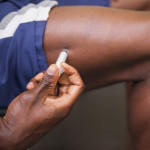An international team of researchers presented follow-up results from a Phase II study of rilpivirine (TMC-278), Tibotec’s experimental non-nucleoside reverse transcriptase inhibitor (NNRTI), August 5, at the XVII International AIDS Conference in Mexico City. The 96-week data indicate that, when combined with Truvada (tenofovir plus emtricitabine) or Combivir (zidovudine plus lamivudine), rilpivirine has results similar to leading NNRTI Sustiva (efavirenz).
Study C204 is a 96-week study comparing three once-daily doses of rilpivirine to Sustiva, all in combination with Truvada or Combivir. Ninety-three patients have been randomized to a 25 milligrams of rilpivirine group, 95 to a 75 mg group, 91 to a 150 mg group, and 89 to Sustiva. All patients enrolled into the study were treatment-naïve, meaning that they had not taken any other HIV medications in the past.
About 33 percent of the study participants are women. Combivir was used by 76 percent of the study volunteers; Truvada by 24 percent.
At study entry, the average viral load was about 70,000 and the average CD4 count was 203.
Interestingly, those on the lowest dose of rilpivirine appeared to have the greatest virologic response to treatment, albeit by a slim margin. After 96 weeks of treatment, viral loads below 50 copies—undetectable—were documented in 76 percent of those in the 25 mg group, 72 percent of those in the 75 mg group, and 71 percent in the 150 mg group. Statistically speaking, these data were comparable to the 71 percent undetectable rate in the Sustiva group.
CD4 count changes did not differ significantly between the groups; average increases of 146 to 172 cells after 48 weeks of treatment were reported.
Relatively few patients in the study experienced viral load rebounds on therapy with genetic mutations conferring resistance to either rilpivirine or Sustiva. This occurred in 6 percent of those in the combined rilpivirine groups and seven percent of those in the Sustiva group.
In the rilpivirine groups, about 9 percent of patients experienced rash, compared with 21 percent of those in the Sustiva group. Central nervous system effects—such as dizziness, drowsiness and vertigo—were significantly more common in the Sustiva group (48 percent) compared with the rilpivirine groups (31 percent). Patients in the rilpivirine groups also experienced fewer abnormal dreams and nightmares—3 percent among those taking rilpivirine vs. 11 percent among those taking Sustiva.
Total cholesterol increased by 9 mg/dL and “bad” LDL cholesterol increased by 4.5 mg/dL in the rilpivirine groups. In the Sustiva group, total cholesterol increased by 34.5 mg/dL and LDL cholesterol increased by 18.2 mg/dL. Triglycerides decreased by 9.8 mg/dL in the rilpivirine group; they increased by an average of 29.2 mg/dL in the Sustiva groups. All differences reported were statistically significant.
Of possible concern were abnormal heart rhythm measurements—prolonged QTc intervals determined using an electrocardiogram (ECG)—seen in some patients treated with rilpivirine in the study. Zala reported that it was most often seen in patients who also took Combivir (zidovudine and lamivudine). Abnormal ECG measurements were least pronounced in the 25 mg dosing group—the dose Tibotec plans to study more closely in Phase III clinical trials.
Advertisement
Advertisement
Advertisement






Comments
Comments